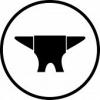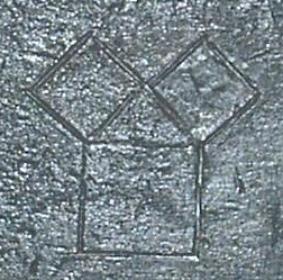-
Posts
253 -
Joined
-
Last visited
Content Type
Profiles
Forums
Articles
Gallery
Downloads
Events
Posts posted by Jakesshop
-
-
4 hours ago, Frosty said:
What's wrong with the stand? Looks like you only need to turn the anvil 90* and drop in the bolts or pins to hold it in place.
Nice score by the way. How's it work?
Frosty The Lucky.
I want to modify the stand with wheels and a handle to make it easier to move about. Also make some decent tool/hammer holders on the sides. Rebound is pretty good and it has a very loud ring to it, louder then most I've played on. I haven't gotten around to using it yet, this one will be for when I have a group of people here for workshops. I already have the anvil of my dreams for a main shop anvil. A 475# S&H south German style double horn.
-
On 10/28/2016 at 0:33 PM, D.C. said:
Very cool score. I can't find a pic, but I think there were several of these in the learners tent at the ABANA conference in SLC this year.
I was there too and missed that!! Darn!!!!
-
I just recently picked this rare CES, California Electric Steel anvil in near pristine condition. It was manufactured in Angles Camp California which happens to be only a couple hours north of me. The gentleman I bought this from purchased it new from CES before 2000. Anvils in America lists this anvil on page 512. They only show that they made one size of anvil called the Model 200. Specs are as follows: Weight: 188 pounds. Material: 4135 Steel. Heat Treated to Rockwell 42-45c. They sold new back in 1997 for $551.25. As far as I can tell the foundry is still in operation but not making anvils anymore.
I need to fix the stand it came with or make a new stand for it before I put it back in use.
-
I recently picked up this 168 pound Attwood along with a few other anvils from England. Rebound is at 60%+. Without the markings you would think it was a Mousehole with the triangular feet and how the underside of the horn is finished. Just doesn't have the MH handling hole on the front feet.
-
Just a guess.... Maybe a late model Mousehole? I have one that could be this ones twin but at 150 pounds. Mine does have the serial number on the foot though.
-
-
-
On 5/2/2016 at 9:38 PM, ausfire said:
Great pineapple twists Jake. I like the chunky appearance and the oil (?) finish too.
I see you make them with the rail spike head either up or down. I used to do all mine (just an ordinary twist) with the heads up until someone commented that they would be more comfortable in the hand if they were point down. Now I make a variety.
My next one will have a pineapple twist ... thanks for the pics.
I shot them with a clear spray shellac. Lasts a good long time. The one with the spike head up was done by accident. I wanted it to be the other way but made a mistake in guessing which side to make the lip prior to twisting. That one stays in my shop.
I did score these deep with a chisel to give them the definition I wanted. And yes a good heat for each twisting.
-
I agree with Kossy also. Best to keep it generic. My business logo is what you see to the left here.
-
-
-
-
LOVE IT!! Great job Joey!!
-
That is some nice looking reproductions that you have made!
Hope you find the information you are looking for.
-
-
2 hours ago, kyaw.khl said:
Thanks for the help u guys. Now im starting ring a bell. Did i need to paint anti-rust for the base????
Just wipe it down with some boiled linseed oil. Takes a few days to completely dry but looks good and protects it very well. Be sure to read the instructions on clean up on the can for that stuff can spontaneity ignite rags. If that stuff is not available in your area just wipe it down with a light oil once in a while.
-
-
Now for last S&H I have. This one I acquired early last year and have just recently got a stand made for it and it is now one of my main shop anvils replacing a smaller S&S I had.
Dated 1937 and weighing in at 475 pounds. There was some small amount of edge repair done by the previous owner but they have held up well so far. Rebound is unbelievable at 95%.
Below is when I was laying out the base plate for it, one inch steel plate to help stabilize it.
Completed stand with a swing out tray.
This is the last S&H I have or have access to for now!
-
4 minutes ago, JHCC said:
Could you put a T-handle in the loops on the back (in the middle photo) to give you more leverage moving it around?
That is correct. I don't have a picture with the handle in from the back. You can see the locking bolt for the handle hanging by the small chain. Highly recommend that!
I used square tubing on my later stands I made and had a better fit and easier to make.
The first picture shows them with the handles installed.
-
For my smaller traveling anvils I use this type of stand so I can easily move them around at events.I don't recommend this type of stand for anvils much over 150 pounds for they try to get away from you when tipping.
The front two anvils are a 100 pound Fisher and a 120 pound Trenton with a Fisher in the back at 150.
The above small Fisher was donated to a local museum last year for their small smithy that I get to play in a few times a year.
Rear view showing a swing out tray I made later on.
For one of my maim shop anvils (this one at 406 pounds) I made this three legged stand. The legs are filled with rammed decomposed granite to absorb vibration and add to stability.
-
-
Here is a Carl Schlasse that I had in my shop for a while. It has since gone on to a new home earlier last year. Made in the south German style with a upsetting block. Very clean face with minor chipping at the edges. Great rebound at or over 85%. It weighed in at 224 pounds.
The "Anchor" symbol of a Carl Schlasse anvil. Also the wieght stamp of 101.5kgs.
-
Now for this stake anvil from S&H. Has the rare factory cast iron stand. Most stake anvils were just used with a stamp or a cut wood block. The stake by itself weighs in at 77 pounds but the stand is 405 pounds. I believe this is dated 1881 from the stamp at the base of the anvil or could be dated 1938 from another stamp.
Like the upside down makers stamp.
This mark "38" could be a date of manufacture because it doesn't match a weight in kilograms. This would put it at 83 pounds and it's not even close to that at 77 actual pounds.
The stamped "81".
Lead pocket for the base to snug it up.
-
A lot of the records from anvil manufactures in and around Germany was destroyed in the bombings of WWII. I too would love to see some detailed information on anvils from there. We are lucky that the manufactures records on anvils and equipment is relatively easy to find here in the US. And with some dedicated individuals like Richard Postman and njanvilman of the Fisher & Norris Factory Museum and many others that are preserving that information.
I haven't seen the addition of the Carl Schlasse to the "Anvils by Brand" yet. Have you started that thread?



Chainmail anyone?
in Metal Sculpture & Carvings
Posted
I did maile for around 20 years at Ren Faires. Made a bunch of coifs in 16 gauge stainless,, they looked pretty cool!! Only made one hauberk, it took me a year to do that. And lo and behold I don't have one picture of them!!